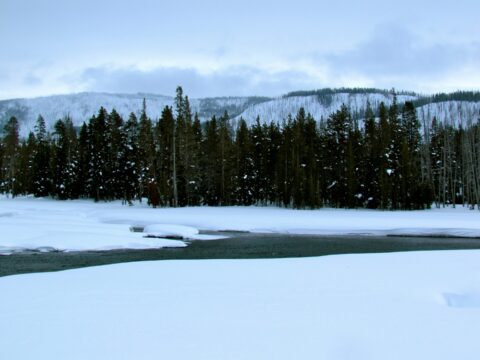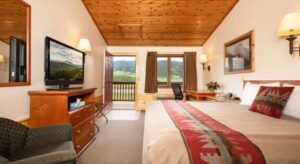What to Do in Yellowstone National Park in the Winter

[caption id="attachment_2685" align="alignleft" width="480"] Photo credit: Jeff Gunn from Atlanta, USA[/caption]
When most people think of Yellowstone National Park, they think of iconic geysers, vibrant hot springs, and the occasional foreign tourist becoming a cautionary tale about why getting close to bison is bad. But there's a whole other side to this natural marvel that comes out in the winter. After all, there’s something really metal about fire and ice together. If you want to witness steaming geysers and bubbling hot springs framed by glistening snow and pretend you’re part of a Scandinavian rock band, you’re in luck. Let’s take a look at all there is to do in Yellowstone in winter.
Photo credit: Jeff Gunn from Atlanta, USA[/caption]
When most people think of Yellowstone National Park, they think of iconic geysers, vibrant hot springs, and the occasional foreign tourist becoming a cautionary tale about why getting close to bison is bad. But there's a whole other side to this natural marvel that comes out in the winter. After all, there’s something really metal about fire and ice together. If you want to witness steaming geysers and bubbling hot springs framed by glistening snow and pretend you’re part of a Scandinavian rock band, you’re in luck. Let’s take a look at all there is to do in Yellowstone in winter.
 Photo credit: Jeff Gunn from Atlanta, USA[/caption]
When most people think of Yellowstone National Park, they think of iconic geysers, vibrant hot springs, and the occasional foreign tourist becoming a cautionary tale about why getting close to bison is bad. But there's a whole other side to this natural marvel that comes out in the winter. After all, there’s something really metal about fire and ice together. If you want to witness steaming geysers and bubbling hot springs framed by glistening snow and pretend you’re part of a Scandinavian rock band, you’re in luck. Let’s take a look at all there is to do in Yellowstone in winter.
Photo credit: Jeff Gunn from Atlanta, USA[/caption]
When most people think of Yellowstone National Park, they think of iconic geysers, vibrant hot springs, and the occasional foreign tourist becoming a cautionary tale about why getting close to bison is bad. But there's a whole other side to this natural marvel that comes out in the winter. After all, there’s something really metal about fire and ice together. If you want to witness steaming geysers and bubbling hot springs framed by glistening snow and pretend you’re part of a Scandinavian rock band, you’re in luck. Let’s take a look at all there is to do in Yellowstone in winter.
Snowshoeing and Cross-Country Skiing
If there’s one thing we dislike about Yellowstone in the summer, it’s the crowds. Nothing ruins a view like a giant tour bus parked in front of it. But imagine you’re snowshoeing or cross-country skiing through a pristine wintry glade, silent except for the crunch of your footwear against the top layer of snow. That's Yellowstone in winter for you. Looking for an easy route to start? Try Old Gardiner Trail, Lone Star Geyser Trail, or Black Sand Basin Trail. Snowshoeing and cross-country skiing deserve a post of their own, so stay tuned.Wildlife Watching
While some animals migrate or hibernate during the winter, Yellowstone's wildlife remains active. Spotting wolves, elk, bison, and other creatures against the snowy backdrop is a photographer's dream—and indeed, Jackson’s art galleries are filled with that stuff. Here are a few places to try getting a glimpse of wintry wildlife:- Lamar Valley: Grab a four-wheel drive vehicle and head northeast. This place is like the VIP section for Yellowstone's wolf packs. But it's not just wolves strutting their stuff here; you can also catch bison, mule deer, and coyotes.
- Firehole River: You’ll need a guided tour crew, but check out the Firehole River between Madison Junction and Old Faithful, where the trumpeter swans munch on . . . whatever swans eat. (Our research ended there. Find out yourself.)
- Mammoth Hot Springs: Check out a cold-air hotspot for viewing bison, coyotes, and eagles.
- National Elk Refuge: We’re particular about this one, where thousands of elk winter every year. You can spy on these majestic creatures from lookout points, or you can hop on a guided sleigh ride through the refuge (check out our upcoming post on the topic! Or just book a room and Flat Creek Inn and bring binoculars.
Snowcoach Tours
Don’t want to brave the elements? Yellowstone has you covered. Take a guided snowcoach tour—a hulking bus racing along on giant wheels or treads, like something from an oddly chill Mad Max movie. Taking one of these heated vehicles is a comfortable and scenic way to witness the park's highlights.Winter Lodging and Hospitality
While several park lodges close during winter, select accommodations remain open, offering a cozy retreat after a day of adventure. And may we suggest Flat Creek Inn . . .Tips for Your Winter Adventure
- Pack accordingly: Dress in layers and bring appropriate gear for snow activities.
- Check for road closures: Some roads may be closed, but many areas remain accessible.
- Book early: Lodging and tours often fill up quickly, so plan and reserve in advance.

